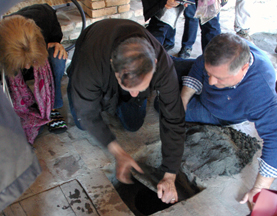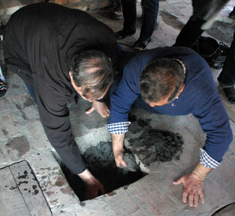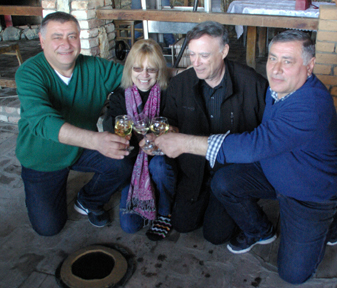We returned to Twins Wine Cellar in Napareuli six months after starting a qvevri wine. The Rkatsiteli grapes fermented and remained on its chacha (grape skins and seeds) until April 1, 2014. During the six months the wine aged and natural filtration took place in the qvevri.
When we arrived the surface of the qvevri was covered. There was a layer of black sand over the covering. Gela Gamtkitsulashvilis, one of the twins that owns the winery, helped me clear away the black sand. It was a bit dry, so water was added to moisten it. That cut down dust particles that were airborne. A brush was used to brush the sand into a corner to make it easier to remove.
 Terry then grabbed the slate covering and lifted it. There was suction between the lid and the qvevri so it took a bit of force to lift the cover. On the reverse side of the qvevri a ring of clay could be seen. This clay formed a seal between the slate cover and the top of the qvevri.
Terry then grabbed the slate covering and lifted it. There was suction between the lid and the qvevri so it took a bit of force to lift the cover. On the reverse side of the qvevri a ring of clay could be seen. This clay formed a seal between the slate cover and the top of the qvevri.
After the qvevri was opened, clear wine was noticed at the surface. Several inched below the surface, you could see the chacha. With a wine glass, I stirred the surface and then put wine into the glass. The first taste of our qvevri wine, well I forgot. Caught up in the moment, I did not reach for pen and paper to take notes. I do recall that it had a light gold color, flora aroma and taste with some fruit character and mild tannins. It was a lighter body than other qvevri wines and the tannins were milder. Many people in the media group seemed to like this. We did not put any stems in the qvevri when we made this wine so we did not get the darker color, more body and harsher tannins that other white qvevri wines have. There is a wide spectrum of white qvevri wines and our was extremely palatable.
 Kathy and I posed for photos with both owners Gela and Gia Gamtkitsulashvilis. I then proceeded to take glasses, give the surface of the wine a gentle stir and fill with a tasting for each of the media group and Twins Wine Cellar staff. Then we started bottling the wine. I went straight to the corker, a device I have had plenty of experience using. Labels were placed on the bottles and signed by the Gia and Gela and myself. The qvevri only produced 13 bottles of wine. Kathy and I took six and Tamta took three. Tamta helped us harvest the grapes and make the wine last September. The owners and a staff person took three bottles and one bottle mysteriously disappeared. I expect an over exuberant member of the media decided to help herself. Kathy and I plan to use our bottles when we have classes that teach about Georgia, the Birthplace of Wine and qvevri wines.
Kathy and I posed for photos with both owners Gela and Gia Gamtkitsulashvilis. I then proceeded to take glasses, give the surface of the wine a gentle stir and fill with a tasting for each of the media group and Twins Wine Cellar staff. Then we started bottling the wine. I went straight to the corker, a device I have had plenty of experience using. Labels were placed on the bottles and signed by the Gia and Gela and myself. The qvevri only produced 13 bottles of wine. Kathy and I took six and Tamta took three. Tamta helped us harvest the grapes and make the wine last September. The owners and a staff person took three bottles and one bottle mysteriously disappeared. I expect an over exuberant member of the media decided to help herself. Kathy and I plan to use our bottles when we have classes that teach about Georgia, the Birthplace of Wine and qvevri wines.

Terry collects a tasting of the qvevri wine for members of the International Wine Tourism Conference media and Twins Wine Cellar staff.
The experience of harvesting Rkatsiteli grapes, cleaning the qvevri, sanitizing the qvevri, putting the grapes in the qvevri and finally opening it was extremely valuable. We will share this experience over and over with our readers and during our classes.
Cheers,
Terry
-1.5in.jpg)




One Trackback
[…] – Opening our Qvevri Wine […]